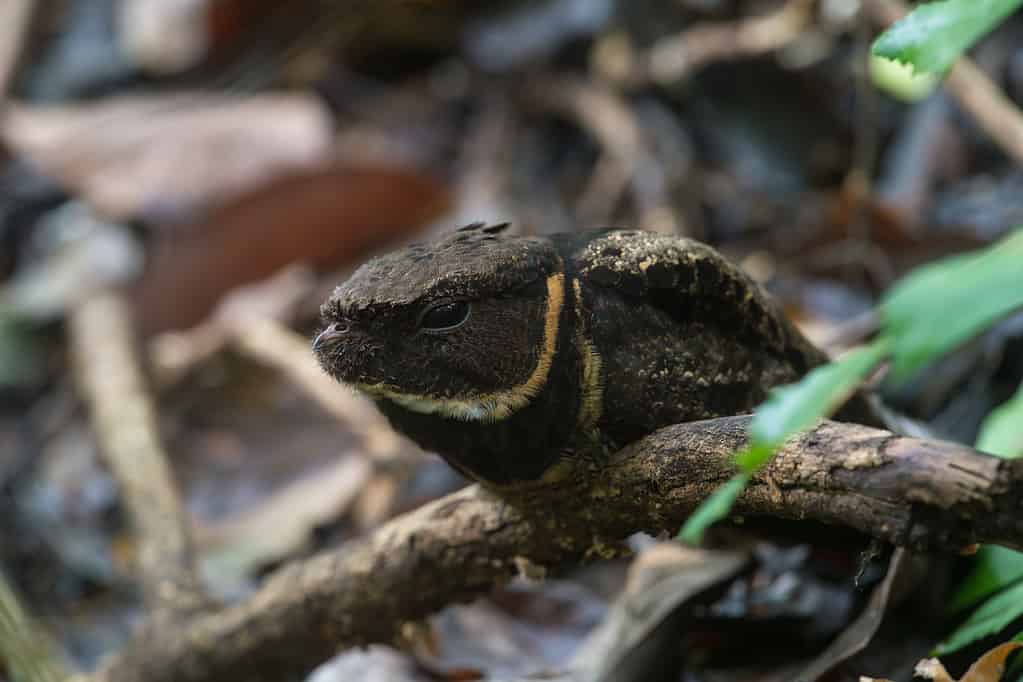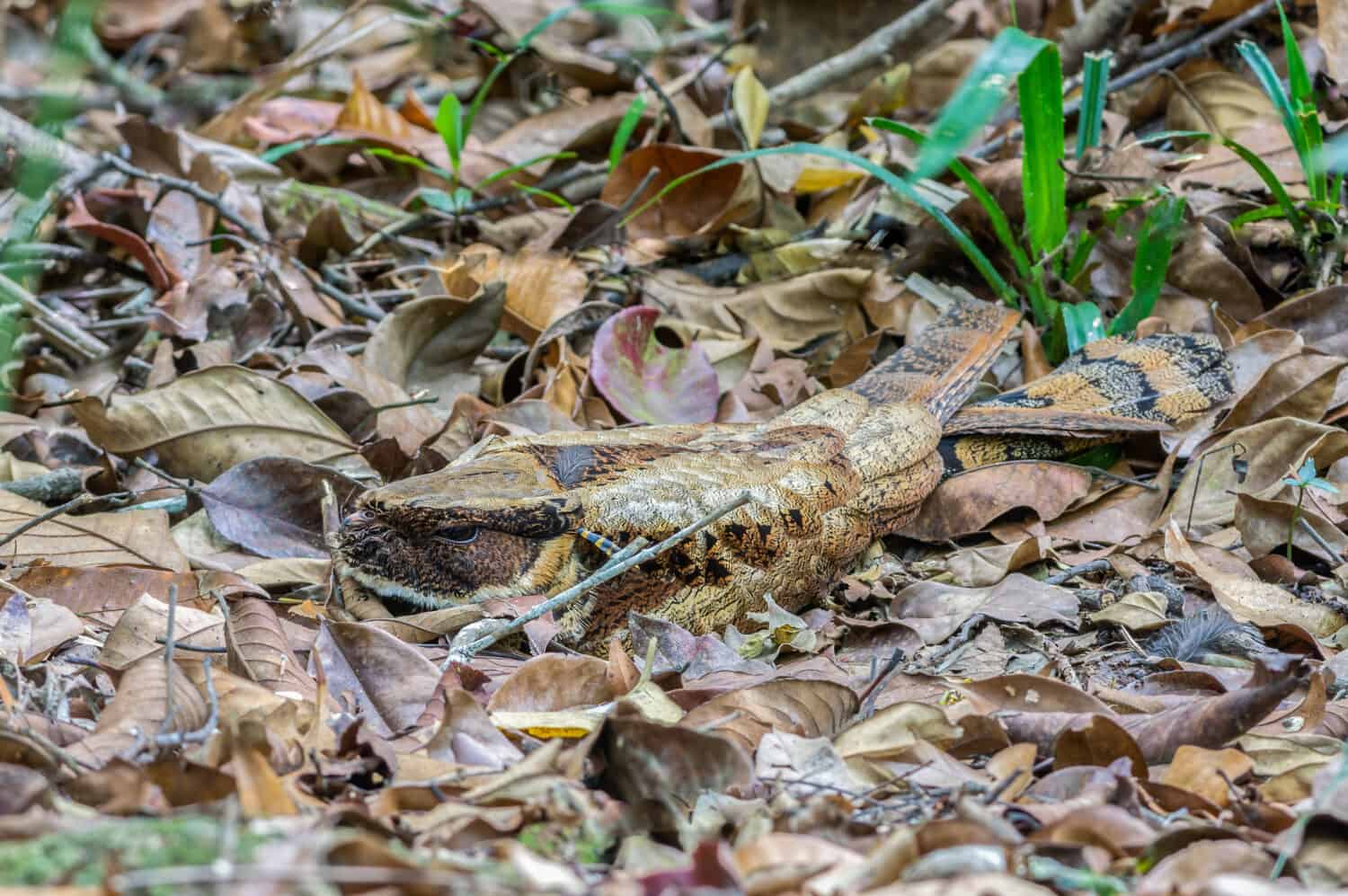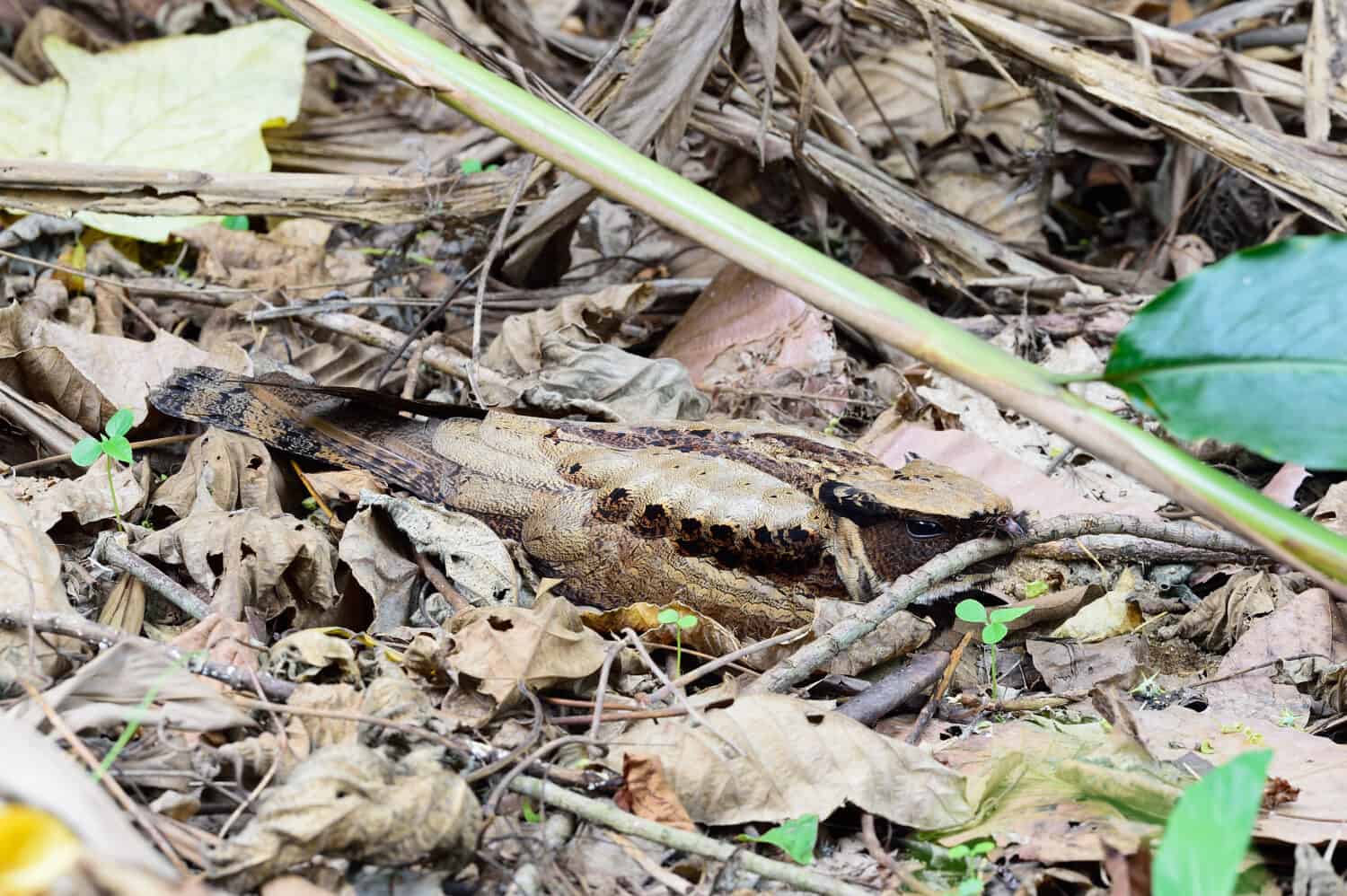In the heart of Southeast Asia’s dense forests lives a creature unlike any other. With its long-pointed wings, large piercing eyes, extraordinarily wide maw, and horn-like feathers, this majestic bird exudes an otherworldly presence that makes it seem almost magical. If you’re lucky enough to catch a glimpse of one, you’ll wonder if it’s a real-life animal or a figment of your imagination. Meet the great eared nightjar — the majestic bird that looks like a dragon! It is a true wonder of the natural world!
The great eared nightjar (Lyncornis macrotis) belongs to the Caprimulgidae family, a rather unique group of birds. Its name comes from its habit of hunting at night, as well as the harsh or jarring sound of its unique call — hence, the name “night-jar”.
Nightjars are also sometimes called bugeaters, because they eat insects that they snatch in the air. Or some people call them goatsuckers — but don’t worry, they don’t actually harm goats! “Goatsucker” actually comes from the bird’s scientific family, Caprimulgidae. “Caprimulgus” is a Latin term that combines “capra” or “goat” and “mulgere” or “to milk”.
But why would anyone name this little dragon-like bird a “goatsucker”? Well, long ago people heard the unique calls of the nightjar, some of which can sound like the bleating of a goat. Unable to actually see these birds as they flew through the darkness of the night, some began to think that they were mysterious creatures who snuck onto farms and suckled milk from their goats!
The belief that nightjars suckled milk from goats at night may seem far-fetched to us today, but it’s a testament to how these enigmatic birds have fascinated humans for generations. Even today, scientists are continually working to uncover the secrets of their unique biology and behavior, and there is so much more to learn! For now, let’s take a closer look at what we do know about the mysterious great eared nightjar.

Like other nightjars, great eared nightjars are sometimes called bug eaters or goatsuckers.
©NABA CHOUDHURY/Shutterstock.com
Unique Appearance: Exploring the Striking Features and Dragon-like Characteristics
If you’re looking for an adorable and feathery miniature dragon, look no further than the great eared nightjar! This intriguing bird is the largest in its family, measuring 12 to 16 inches long. It is also the second heaviest species in the nightjar family as well, weighing in at 4.6 to 5.3 ounces. However, it’s not the bird’s size that gives it such a memorable appearance, but rather its enchanting face.
The golden feathers covering the bird’s head look like a little armored cap. They transition into long ear-tufts that look like little dragon-scaled horns. Its tiny beak only adds to its unique character, mostly hidden behind fluffy feathers. However, while its beak may be small and weak, the great eared nightjar has a surprisingly large mouth. It can open its mouth open super wide — revealing a bright pink maw that is almost as large as the bird’s face!
The great eared nightjar can open its mouth super wide, revealing a gaping maw lined with long and delicate bristles. These sensitive bristles spread out and create an organic net of sorts. This helps the bird to catch insects and funnel them down into its mouth.
The great eared nightjar has a plump, rounded body with long slender wings and a long tail. Its mottled feathers are a beautiful blend of brown, chestnut, white, black, and gray hues. They provide excellent camouflage for this stunning bird.
Adding to its exceptional charm are the bird’s enormous eyes, which often narrow in a look of scrutiny or judgment, or open wide with wonder and curiosity. The great eared nightjar’s long ear-tufts can be seen even when it’s lying down, making it look like a regal little dragon hatchling straight out of a storybook!

Although great eared nightjars have tiny beaks, they can open their mouths exceptionally wide.
Habitat and Distribution: Understanding the Range and Preferred Habitats of this Majestic Bird
The great eared nightjar lives in the moist, lowland forests in southwestern India and in regions of southeastern Asia. This incredible little bird can survive in several different types of habitats. However, it prefers forests and forest edges with dense vegetation. This provides the perfect backdrop for the great eared nightjar to camouflage from predators. Blending in seamlessly with its surrounding environment, the bird can safely nest on the ground and swoop between trees to feed.
Some great eared nightjars also live in other tree-covered areas, like plains and fields, where they can hunt insects. However, they always choose habitats with plenty of vegetation and tree cover. So, you will never spot one somewhere like grassland or desert regions.

The colors of the great eared nightjar allow it to blend in seamlessly with its environment.
©Narupon Nimpaiboon/Shutterstock.com
Fascinating Behaviors and Adaptations
While its appearance is certainly spectacular, the great eared nightjar also has incredible behaviors and adaptations that are just as impressive. These captivating birds have very distinctive calls that add to the enchanting melodies of forests at night. First, they emit a sharp “tsiik” that pierces the stillness. This is followed by a brief pause before the second part of the call — a melodious two-syllable “ba-haaww”, which rings through the trees like music. Their call can be heard all night long as nightjars communicate with one another, staying connected even when they’re out of sight.
Its long wings are broad and allow it to fly quietly. These majestic birds glide low to the ground, flapping their wings with slow and graceful movements as they hunt for insects in the dark of night. They can also fly slowly with incredible control, allowing them to sneak up on and catch insects in mid-flight. And they don’t just eat while flying — they can drink too, scooping up fresh water as they glide past rivers and lakes.
However, even though they are excellent fliers, great eared nightjars spend much of their time on the ground. In fact, they even nest on the ground! Great eared nightjars don’t really build nests. Instead, they just choose a spot in a depression or shallow scrape with leaf litter and forest debris.
Female great eared nightjars only lay and incubate one single egg at a time. They sit on the egg throughout the day, using their excellent camouflage feathers to keep it safe from potential predators. At night the females leave to hunt for food, while the male birds take over egg-sitting duties. When chicks hatch, they are covered in soft and brown downy feathers. This helps them to hide among the leaf litter.

Unlike most birds, great eared nightjars nest completely on the ground!
©Lovely Bird/Shutterstock.com
Conservation Status and Importance
At the moment, the great eared nightjar is listed as a “least concern” species on the IUCN Red List. However, it’s hard to know exactly how many there really are in the wild. Researchers are still learning about these remarkable birds, and unfortunately, they are vulnerable, especially to human disturbances and habitat loss.
Great eared nightjars are not only amazing animals, but they are very important to the ecosystems where they live. That is why it is so essential to protect their habitats and keep the forests healthy. Fortunately, there are programs and dedicated individuals working to help protect and conserve great eared nightjars and their habitats. One of the top priorities in protecting the great eared nightjar is establishing intentionally protected areas. These special zones provide a safe haven for not only the nightjar but also other wildlife that depend on the same habitat.
Sustainable land use practices are also key in preserving the great eared nightjar’s habitat. We need to adopt responsible land use practices that protect the birds’ homes and prevent further damage. Together, we can make a significant impact in securing the future of the great eared nightjar and its precious habitat.
In addition, educating the public about the threats facing this species is crucial. By raising awareness and sharing knowledge about the great eared nightjar, we can all contribute to reducing human disturbance and ensuring that these birds have a peaceful and thriving environment.

Great eared nightjars live in lowland forests in Southwestern India and regions of Southeastern Asia.
The photo featured at the top of this post is © jasonbkk / CC BY 2.0 – License / Original
Thank you for reading! Have some feedback for us? Contact the AZ Animals editorial team.







